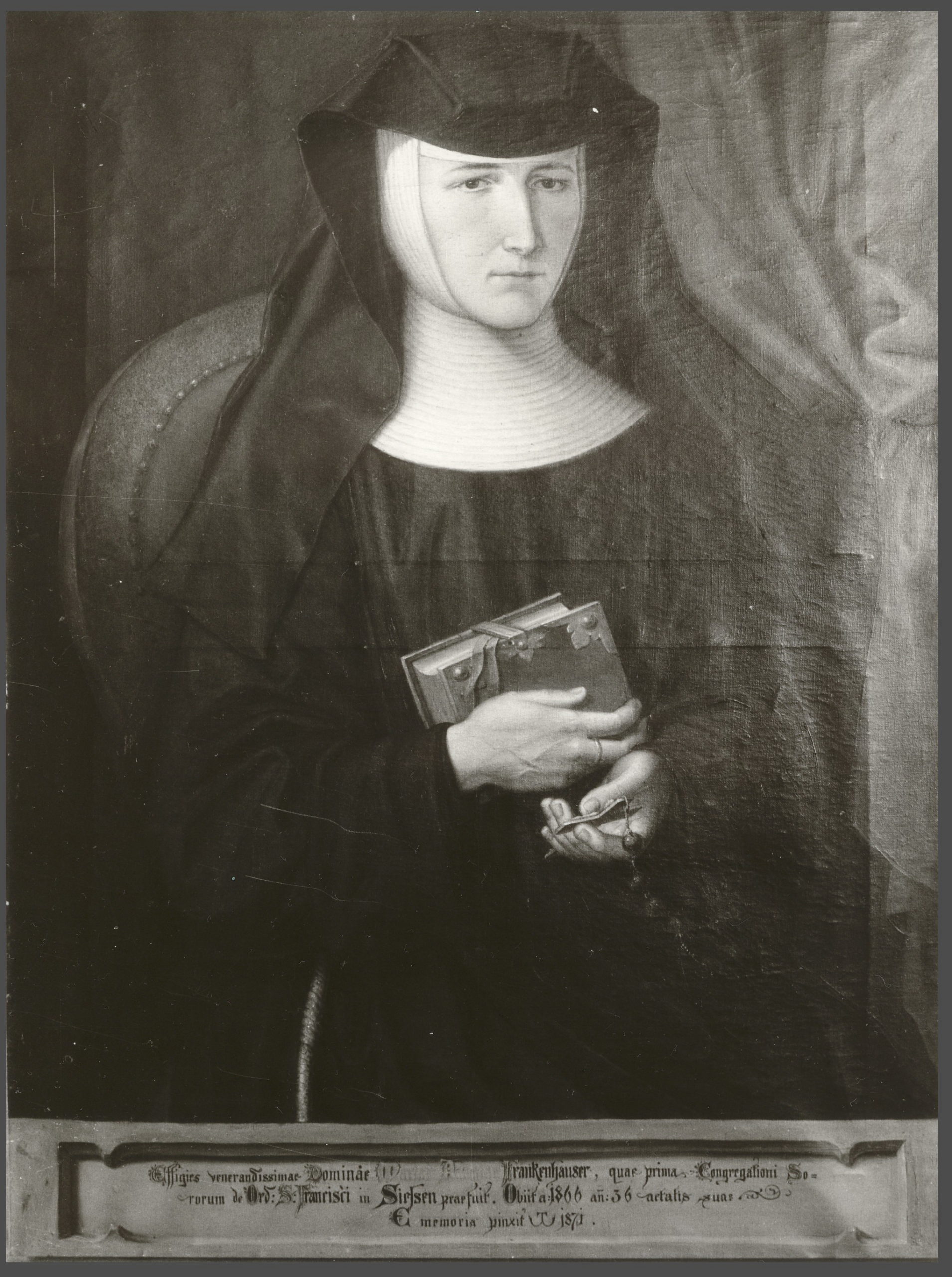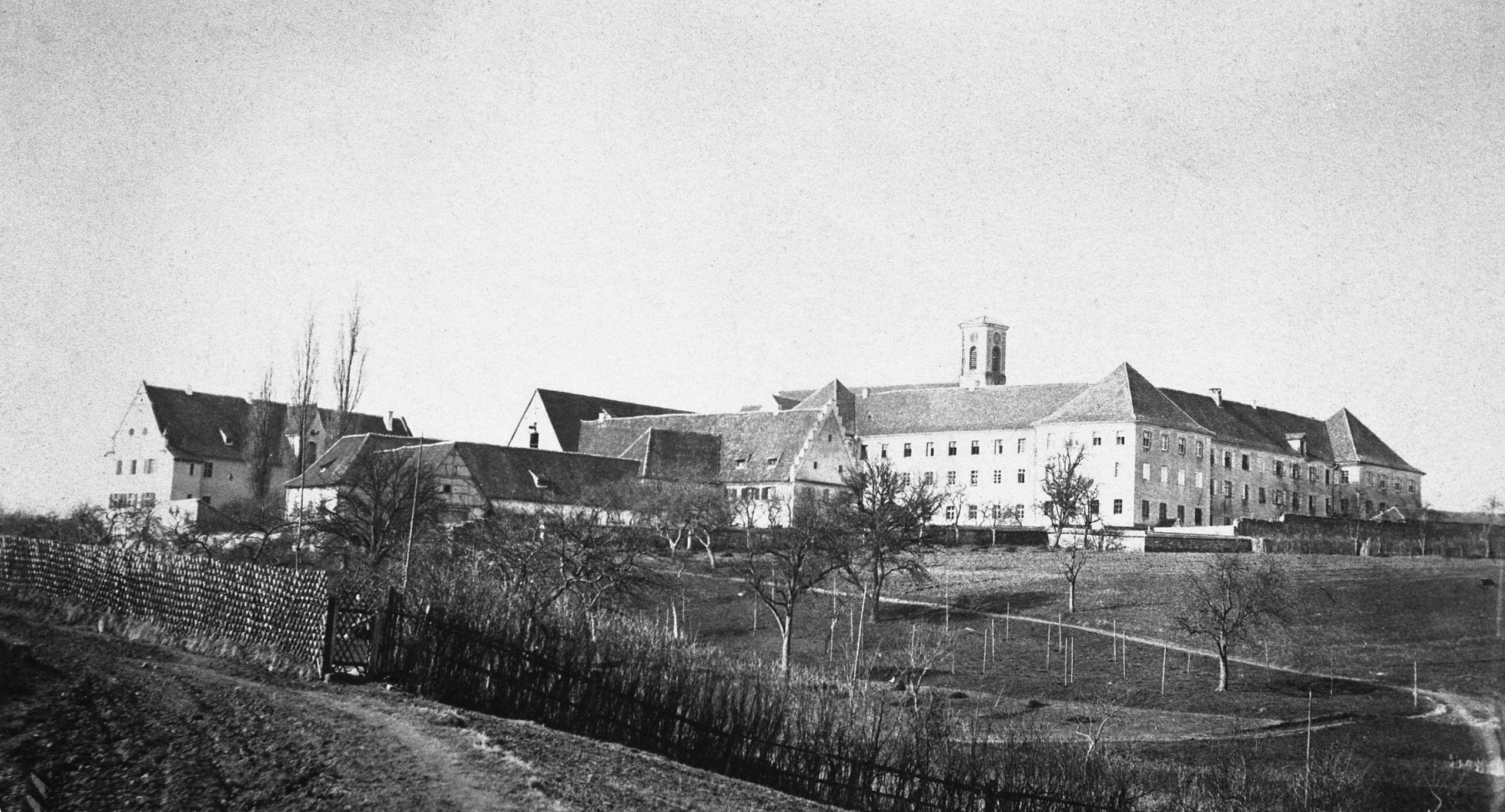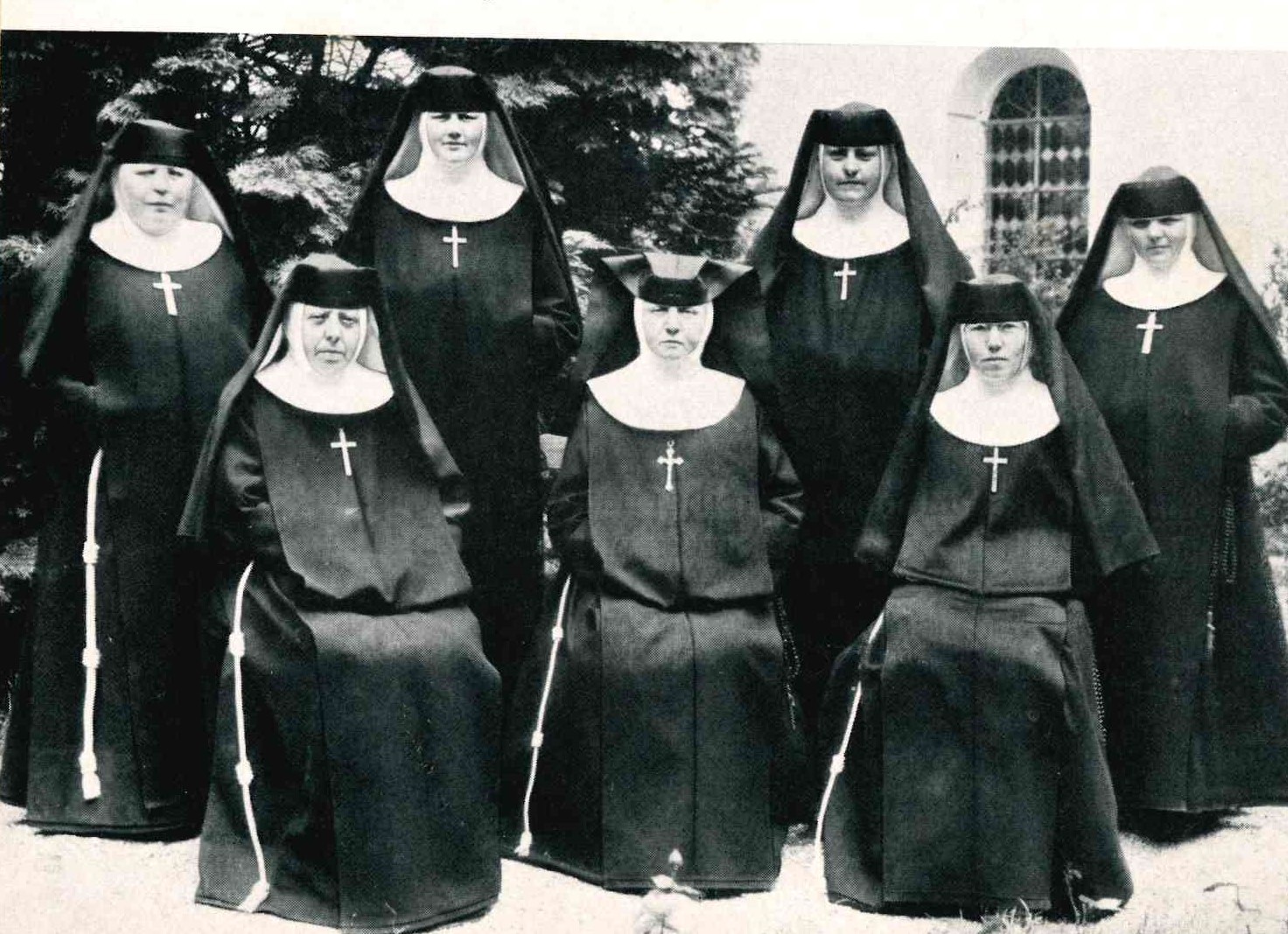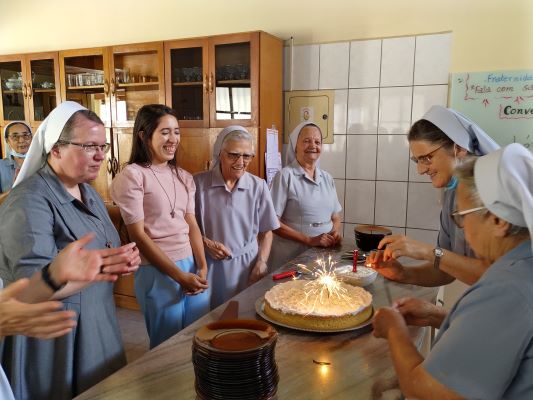In a short and in a long version
Short version
02.03.1854
Foundation of the “School Sisters of the Third Order of St. Francis” in Oggelsbeuren as a subsidiary of the Franciscan Sisters of Dillingen.
1860
Relocation to the former Dominican Convent in Siessen near Bad Saulgau.
Rapid growth of the Congregation despite many limitations. Schools are established in various locations.
1932
Departure of the first group of Sisters to South Africa.
1936
Departure of the first group of Sisters to Brazil.
1939-1945
World War II. In Germany, major problems due to the policy of the National Socialists. The Motherhouse is confiscated. Towards the end of the war, major bomb damage to the schools.
Contact with South Africa and Brazil is hardly possible any more.
After the war, a lot of rebuilding work and yet new sendings to South Africa and Brazil.
1961-1965
2nd Vatican Council
Important innovations in the Church and religious life bring much movement and controversy to the Congregation. Each region is facing the challenges of this time. In addition to educational work, more and more pastoral and social tasks are being taken on.
1996
South Africa and Brazil become Provinces.
2020
Germany becomes a Province and the changed structure of the Congregation comes into force.
Long version
Foreword
From the beginnings of the Church, God has called people again and again, like the first disciples, to leave everything and follow Jesus, to serve him with their gifts and abilities. In a time of crisis in the Church, Francis heard and grasped this mission anew and, listening to God’s guidance, found a contemporary form of religious life that quickly attracted many brothers.
The branch of the “Poor Women” under the leadership of St. Clare also developed very quickly. To this was added the Third Order for people remaining in the world and in their families, living the Franciscan ideal. At the end of his life, Francis said: I have done my duty, may Christ now teach you yours.
From these roots, diverse forms of Franciscan religious life emerged throughout the world. Out of the Third Order Religious Congregations of the so-called Regulated Third Order developed, to which our Congregation belongs.
Foundation
After the secularization in 1782 and 1803 brought religious life in Germany almost to a standstill, new opportunities opened up in the mid-19th century. In Upper Swabia, near the town of Ehingen, young women, their parents, and the spiritual school inspector Joseph Kuonz came together to found the dream of a female Religious Community to teach girls.
The young women were in school in Bavaria with the Franciscan Sisters of Dillingen and were also candidates there. Step by step, the dream of reviving the Convent in Oggelsbeuren, where only one Sister of the former Franciscan community still lived, could be realized. Bishop Josef Lipp of Rottenburg approved the plan on November 15, 1853. Mother Theresia Haselmayer of Dillingen had already agreed to send Sisters for the new beginning.
On March 2, 1854, monastic life began in the old Convent in Oggelsbeuren, which the parents had bought and renovated. The school had started a little earlier, led by candidate Franziska Frankenhauser.
Shortly after moving in, the first dressing took place. The three newcomers were named: M. Antonia Frankenhauser, M. Franziska Seraphika Model and Maria Klara Höß.
M. Antonia Frankenhauser was elected the new superior of the community immediately after her first profession in 1857.


From Oggelsbeuren to Siessen
The Congregation and the school grew, so that the old Convent quickly became too small. Therefore, the community looked for a new place and found it in the former Dominican Convent in Siessen near Saulgau. Here also still lived one of the former residents. Dominican Sisters had lived there since 1260 and left a beautiful Convent complex for the new residents. However, the real treasure of the Convent was and is a Romanesque cross, which had accompanied the Dominican Sisters throughout the centuries and had given them support and comfort in all darkness.
On May 24, 1860, the Convent, school and boarding school moved from Oggelsbeuren to Siessen.
Development of the mission
Mainly political difficulties caused problems for the small community. But nothing could stop it from growing. The mission they had brought with them from Dillingen, and which they fulfilled wholeheartedly, was the education of girls. In addition to the school in Siessen, schools were established in a number of towns in the Diocese of Rottenburg, and there were many smaller branches in rural areas where the Sisters were also active in school and kindergarten.
After the First World War and the great economic hardship in Germany, many Sisters lost their jobs at the school. Therefore, the Congregation also opened up to nursing.

From Siessen into the world
There were repeated requests for the Sisters to work abroad. The Congregation had rejected this, pointing out that the forces were needed in Germany. It took the mission-enthusiastic Superior General M. Gertrudis Bosch and difficult external circumstances for the Congregation to decide to take the plunge in response to the request from South Africa. In 1932, the first Sisters left for South Africa, and in 1936, the first Sisters left for Brazil.

The names of the first Sisters who left for South Africa are
Sr M. Sidonia Haaga, Sr M. Ludovika Maier, Sr M. Matthia Steck,
Sr M. Sindulfa Wetzel, Sr M. Caritina Erne and Sr M. Bernadette Ziegler.
The first group to leave for Brazil were Sr M. Ida Ensle,
Sr M. Konrada Nagel, Sr M. Goswina Walter and Sr M. Henrica Lang.

Loyalty to the mission in difficult times
The beginning for the little plant in Agudos in the State of São Paulo in Brazil was difficult. The Sisters worked there in the school and in the hospital. Only three years after the arrival of the first Sisters, when the group had grown to 14 Sisters, contact with the Motherhouse almost completely broke off due to the beginning of World War II. So the Sisters had to wait until 1948 for reinforcements to arrive from Germany. But their life also attracted young women in Brazil. The first clothing took place on February 22, 1948. From the beginning, the Sisters had a lively contact with the Franciscans.
The beginning in South Africa was not without obstacles either. For a period of introduction to missionary work, the Sisters came to Mafikeng and Taung in the Diocese of Kimberley and also to the Sisters of the Holy Cross in Aliwal North. In search of their own mission station, the sisters had to move several times, even to Botswana, until they were finally able to acquire Fort Savage Farm, which is now called Assisi Mission and is located in the Archdiocese of Bloemfontein.
On October 19, 1952, our community took even deeper root in South Africa with the consecration of the first four novices.
In Germany, this period was very difficult due to the rule of the National Socialists and the Second World War. Much of what had been built in the decades before had to be finished and cleared, a lot was destroyed. The Motherhouse was confiscated. After the war, the Motherhouse was returned and the schools could start anew. However, most of the buildings were destroyed and the reconstruction required an enormous effort from all the Sisters.

Back to the roots and forward to the future
The world had changed a lot after the Second World War. The Church, too, could not simply go on like this. Thus, Pope John XXIII summoned the Second Vatican Council, which placed ecclesiastical doctrine and practice on a new foundation. The mandate to the religious orders was: renewal through reorientation to the roots. In an intense worldwide process, the Third Order Franciscan Congregations renewed their Rule. Our Congregation drew up a new Order of Life, which was valid from 1985. All this meant a departure into new times that should not be underestimated. The Congregation was able to continue building on this foundation.
A changing Congregation in a changing world and Church

In South Africa, the Sisters worked in schools and kindergartens and in pastoral ministry. They also served the poor and the priests. The country experienced a very difficult social and political period under apartheid. This also had a major impact on the Sisters and caused internal conflicts. German and African Sisters were treated differently. The growing tensions erupted in an “uprising” in 1976 when the African Sisters refused to accept this inequality any longer. Also, many Sisters left the Congregation. From that time on, the education of the African Sisters was improved and all the Sisters lived together in the same house. The situation is much better, but the wounds have remained.

In the Brazilian Church, profound changes took place after the Council. Liberation theology brought the poor into focus and many religious went directly to the poorest of the poor to serve them. In our region, too, tensions rose between those who wanted to continue the institutions and those who wanted to be active in pastoral work and to be with the poor. This conflict lasted for many years. One step for the new beginning was the transfer of the novitiate house to Curitiba. When economic problems were added, the schools were sold and the Province moved its headquarters to Guaratinguetá, a radical new beginning, in collaboration with the Fazenda da Esperança.

In Germany, the phase after Vatican Council II was associated with much unrest and major upheavals in the Church and in society. The result was a shortage of vocations. It was not until the 1980s that this experienced a new revival. Wise decisions of the Superiors made the Franciscan Sources come alive for all. Each Sister was allowed to go to Assisi. The ongoing formation supported the spiritual and personal maturation and the communication skills of the Sisters. There were again more vocations for our Congregation, often women who already had training in a pastoral profession. So this and also some other fields of activity came into the Congregation. The large organisations such as schools, youth welfare services and retirement homes were given to other trustees.
The new structure of the Congregation
In 1996, the General Chapter decided that the “Regions” of South Africa and Brazil should become “Provinces” with greater autonomy and responsibility.
This reform of the structure of the Congregation was not completed until the 2020 General Chapter, when the branches in Germany also became a Province. To make this step possible, the Constitutions were revised in a long process, involving all the Sisters, and adopted at the Extraordinary General Chapter of 2017-2019. Since the General Chapter of 2020, the Congregation has been working on the other parts of the Order of Life to be approved at the Extraordinary General Chapter of 2025.
And today …
In Brazil, the Sisters live in several Convents in Guaratinguetá / SP. They are active in pastoral work and support the Fazenda da Esperança.
In 1949, the Sisters began their educational work in Garça in a day care center and for a long time also in the school. The Sisters live in a small Convent on the outskirts of the city. They invite people to pray and are pastorally active.
In Coroatá / MA, in the poorer north of the country, the Sisters work in the medical and pastoral care sector, in prison chaplaincy and in catechesis.
In South Africa, the Sisters continue to teach in schools and kindergartens. At the Assisi Mission they have the Regina Pacis Retreat Center, the Bophelo Child and Youth Care Center, and the Rebabaletswe Partial Care Center, as well as a farm. In 1977, the Sisters went to Batlharos. Now they work there in a retirement home in the Diocese of Kimberley. In 1983, they opened a Convent in Botshabelo to be closer to the poor people. They run a kindergarten there. For the same reason, the Sisters started in Bothaville in 2006. In 2009, a Convent was established in Ennerdale. The Archbishop of Johannesburg asked the Sisters to carry out pastoral work in the township of Orange Farm. There are three Convents in Bloemfontein, St. Joseph with kindergarten, in the Bishop’s House as well as the St. Clare Convent for studying Sisters. In this city, they did a good job for HIV patients for a long time.
In Germany, the fields of activity of the Sisters vary a lot. Some work, for example, in the school or pastoral sector and in spiritual centers, some in the medical-therapeutic sector.
In Siessen, the school and boarding school were closed in 1990. A limited liability company was set up for the other schools. As ever, all classes of the “Siessener Schools” still come to the youth center in Siessen at least once during their school career to get to know the place of origin of their school.
The youth center and the adult pastoral care in Siessen offer many opportunities to relax, recharge your batteries spiritually and deepen your religious education. A Convent’s Café and a beautiful guest area invite you to relax.
Some Sisters work in housekeeping, in religious education, in the care for the elderly Sisters and in management and administration of the Congregation.
All Provinces are in a process of constant development and change. Convents are opened and also closed in order to respond to the signs of the times in a rapidly changing world and Church.